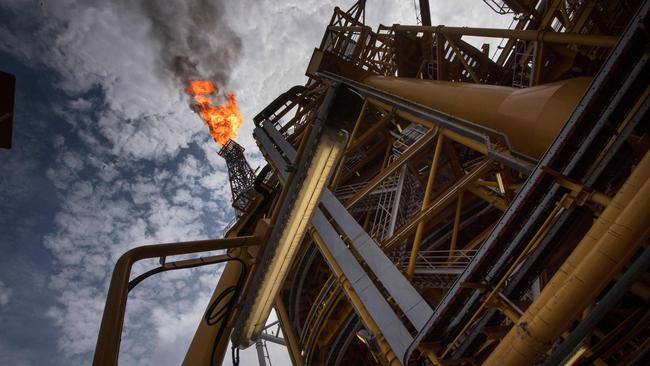Aussie stronger at crunch point for global markets
The Australian dollar and shares were resilient as commodity prices ripped, amid fear of supply disruption from Ukraine and Russia.

It was another volatile week for global financial markets but local markets were well supported.
Continued war in Ukraine, tough new sanctions on Russia and soaring energy prices put global sharemarkets on track for sharp falls as the money flowed to safe havens like bonds and gold as well as commodities that are benefiting from heightened geopolitical tensions.
But the Australian dollar soared to a four-month high of US73.63c – breaking above its 200-day moving average for the first time since June — and the S&P/ASX 200 share index added 1.6 per cent to 7110.8 after its first five-day gain this year, scoring its best week in four.
Friday’s news of Russian artillery strikes on a Ukrainian Zaporizhzhia nuclear power plant – Europe’s largest – sparked panic selling of risk assets including shares after Ukraine’s foreign minister tweeted that the plant was on fire if it blew up it would be 10 times worse than Chernobyl.
But risk assets and currencies rebounded and safe havens and oil prices faded after Ukraine told the International Atomic Energy Agency the fire “has not affected ‘essential’ equipment,” and that there had been no change reported in radiation levels. The reactors were “protected by robust containment structures” and safely shut down, US Energy Secretary Jennifer Granholm said.
The resilient performance of the Australian dollar and shares came as commodity prices ripped amid fear of supply disruption from Ukraine and Russia, with banks reluctant to provide finance.
In energy commodities, Brent crude oil rose 19 per cent across five days to $US112 a barrel, after hitting a nine-year high of $US119.84, while British natural gas rose 19 per cent to £384.05 per thermal unit and Newcastle thermal coal soared 55 per cent to $US370 a tonne as of Friday’s Asian session.
Spot gold rose 2.5 per cent to $US1937 per ounce, iron ore futures rose 15 per cent to $US157.75 a tonne, aluminium rose 9.5 per cent to $US3,717 a tonne, copper gained 4.9 per cent to $US10,351 a tonne, nickel jumped 8.8 per cent to $US26,897 a tonne, zinc rose 7.7 per cent to $US3.921 a tonne and Palladium up 9.8 per cent to $US2.749.80.
But it wasn’t just the favourable commodity price backdrop supporting Australian shares.
The February earnings season saw a “definitive beat” of earnings estimates, with a “beat/miss” ratio of 50:28 per cent versus an average of 50/33 per cent in the past 10 results seasons according to. J. P. Morgan Australia head of research, Jason Steed.
That rate of earnings beats was all the more impressive given the high rate of earnings upgrades running into the season; over 90 per cent of stocks across the ASX 300 saw upgrades in January.
In aggregate it saw a 2.2 per cent month-on-month uplift in consensus earnings for 2021-22.
Earnings expectations were raised for nine share market sectors, with Utilities, Industrials and Energy seeing the largest upward revisions.
Net downgrades to dividends per share estimates was “the only blight” on the reporting season, with the consensus estimate for 2021-22 dropping 1 per cent on average.
But earnings per share growth is set to come in at 13.6 per cent in a “strong year of earnings”, with Energy, Materials and Financials the main contributors, according to Mr Steed.
There was also a positive tilt to earnings guidance, as 70 per cent of stocks in his coverage provided updates and on average they were better than J.P. Morgan expected.
Companies that gave positive guidance outperformed by an average of 3.6 per cent after reporting.
UBS remained bullish on the Australian sharemarket but trimmed its year-end target for the S&P/ASX 200 index to 7700 from 7800, implying a 7 per cent gain from here.
While noting that Ukraine/Russia developments are “understandably causing equities to at least consider a faster move towards stagflation”, UBS equity strategist, Richard Schellbach said reporting season has solidified his view that “we are firmly in a ‘reflationary’ environment.”
And after looking at 13 of the most significant global geopolitical shocks over the last fifty years, he found the Australian share market has “largely dismissed these events”.
The ”standard” historical reaction was for equities to initially fall by 0.1 per cent in the first week, then recover by 5.1 per cent over 3 months and 11.8 per cent over one year of such events.
But underneath the relatively contained reaction at the overall equity market level has been a “clear divergence between sectors,” he said.
Resource stocks have been consistent outperformers, with gold equities performing best, while mining and energy equities also strongly outperforming. By contrast, Financials have shown themselves to be consistent underperformers, with Insurance stocks faring worst.
Macquarie’s Australian equity strategist, Matthew Brooks, cautioned that reporting by individual companies was “mixed”, with a “modest positive surprise on earnings and some upgrades for larger company outlooks”, pointing to aggregate 2021-21 EPS growth of 13.4 per cent.
“But small caps were more likely to miss and have their FY22 EPS downgraded, as they tend to have less pricing power and may be more negatively impacted from the withdrawal of stimulus,” he said.
“Inflation was a key theme in results and one impact appears to be free cashflow disappointment due to some combination of lower margins, higher interest and tax or higher working capital.”
Inventories in particular were higher than expected due to supply chain challenges and he saw this as a potential risk as the cycle slowed.
Cash flow surprise was also the most important driver of post-result share price moves, not EPS surprises. He continues to warn of a “mid-cycle slowdown” during which the Fed will be lifting interest rates to in response to inflation, leading him to a “defensive bias.”



